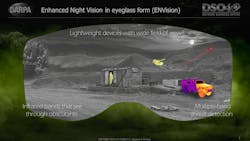Physical Sciences joins list of firms developing small lightweight night-vision electro-optical glasses
ARLINGTON, Va. – U.S. military researchers needed a company to develop night-vision devices far smaller and lighter in weight than today's night-vision goggles, which would be about the same size and weight as a typical pair of eyeglasses. They found their solution from Physical Sciences Inc. in Andover, Mass.
Officials of the U.S. Defense Advanced Research Projects Agency (DARPA) in Arlington, Va., announced a $6.4 million contract to Physical Sciences on Wednesday for the Enhanced Night Vision in eyeglass form factors (ENVision) project.
Physical Sciences joins SRI International in Menlo Park, Calif.; the University of California at San Diego (UCSD); and Raytheon BBN Technologies Corp. in Cambridge Mass. on the ENVision project.
Today's night-vision goggles typically are as bulky as four inches long and as heavy as 2.2 pounds. This causes a large torque on the wearer’s neck, which limits the wearer’s agility and often leads to chronic injury over prolonged use of these electro-optical devices.
Related: Night vision binocular to enhance warfighter low-light capabilities introduced by Harris
Modern night-vision goggles also burden the wearer with a narrow field of view and generally have limited spectral access to the near-infrared spectral band, which limits situational awareness.
This drawbacks from refractive optics for imaging, and image-intensifier tubes -- two technologies in modern night-vision systems that have remained largely the same since their inception.
Instead, the DARPA ENVision program is asking SRI International, UCSD, and Raytheon BBN to overcome these limitations by developing enhanced direct-view night-vision systems that are of a size and weight near those of typical eyeglasses.
SRI International won a $5.2 million ENVision contract on 3 Nov. 2021, UCSD won a $3 million ENVision contract on 24 Sept. 2021, and Raytheon BBN won a $2.3 million ENVision contract on 23 Sept. 2021.
Related: Sensor payloads for unmanned vehicles
The small lightweight night-vision eyeglasses that these three organization will develop are to extend visual access beyond near infrared to include shortwave, midwave, and long-wave infrared spectral bands through a common aperture, giving users access to spectral ranges from 1.5 to 12 microns. These night-vision eyeglasses, furthermore, would widen the user's field of view to natural eyesight of about 100 degrees.
Optical specialists have attempted to widen the fields of view for today's night-vision goggles, but improvements come at the cost of increased systems size, weight, and wear-and-tear on the user. The ENVision project seeks to explore the next technical leap in night-vision technologies by achieving direct vision of the infrared through photon upconversion.
While current night-vision systems use a multi-step process, the physics to upconvert infrared photons directly to visible light in one step has been known since the invention of the laser in 1960. Direct photon upconversion involves the absorption of two or more photons and re-emission of a photon of higher energy.
Related: The evolution of night-vision devices
Currently, these processes are inefficient and are limited in the bandwidth of light that can be upconverted simultaneously. Yet recent advances in material systems such as polaritonic structures and sensitized core-shell nanoparticles have opened up new avenues in exploring photon upconversion.
The process of photon upconversion-based night vision would eliminate the need for several components and could lead to even simpler, all-optical night-vision systems in the future, such as night vision contact lenses, DARPA researchers say.
Planar optics and planar image intensifiers could enable direct vision of several infrared bands through one common aperture. Structured materials such as diffractive optics and metamaterials enable one to embed optical functionalities far beyond those of traditional refractives into one optical element.
While wide field of view, broad bandwidth, and high imaging quality all are achievable individually, combining these traits in practice remains a challenge. In addition to planar optics, image intensification is necessary to convert the often weak infrared light into visible photons detectable by the naked eye.
The ENVision program will last for four years in two two-year phases, and has two technical areas: prototypes and upconversion. Those participating in the first technical area will develop prototypes of enhanced night vision systems in eyeglass form-factors, while those in the second technical area will investigate broadband direct photon upconversion.
For more information contact Physical Sciences online at www.psicorp.com;, UCSD at https://ucsd.edu/research-innovation/; Raytheon BBN at www.raytheonintelligenceandspace.com/capabilities/bbn; or DARPA at www.darpa.mil/program/envision.
About the Author
John Keller
Editor-in-Chief
John Keller is the Editor-in-Chief, Military & Aerospace Electronics Magazine--provides extensive coverage and analysis of enabling electronics and optoelectronic technologies in military, space and commercial aviation applications. John has been a member of the Military & Aerospace Electronics staff since 1989 and chief editor since 1995.
